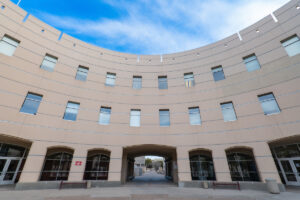DOE taps 10 universities for clean energy workforce development


(New Mexico State University’s engineering complex. NMSU was one of ten universities granted $900,000 by the DOE to establish clean tech training centers. Courtesy: NMSU)
Sites will provide hands-on training for clean energy careers
The U.S. Department of Energy is investing in the future of the clean-tech workforce.
Ten universities have been selected to receive an inaugural grant of $900,000 to establish a Building Training and Assessment Center (BTAC). These sites will “educate and train students and build performance professionals to deploy modern building technologies to small businesses and K-12 schools,” explains the program’s fact sheet. The funding is made possible by the Bipartisan Infrastructure Law.
The recipient institutions are New Mexico State University, Fayetteville State University, Michigan State University, Syracuse University, Texas Tech University, University of Alabama, University of Louisiana-Lafayette, University of Miami, University of Washington, and University of Wisconsin-Milwaukee.

“We’re delighted that New Mexico State University can be part of this important initiative to invest in America’s future workforce,” said NMSU interim President Jay Gogue in a statement. “This program will not only train and prepare New Mexico residents for the clean energy workforce but also help New Mexico businesses with energy assessments.”
U.S. Sen. Martin Heinrich, a member of the Senate Energy and Natural Resources Committee and founder and co-chair of the Electrification Caucus says these investments prepare people “for skilled trades careers that they can build their families around, investing in small businesses, lowering costs and tackling climate change.”
The Industrial Assessment Centers (IAC) and BTAC programs have a two-part mandate to support small businesses and expand the clean energy workforce. The programs aim to help small and medium-sized manufacturers (SMMs) and commercial and institutional buildings accomplish a variety of things, including saving energy, reducing greenhouse emissions, and improving productivity and performance. They aim to bolster the clean energy workforce and broaden paths to clean energy careers that don’t require a four-year degree.
Numerous attendees at this year’s Interstate Renewable Energy Council Vision Summit lamented the lack of young, qualified engineers in the workforce. A lack of adequate training and changing technology were cited as reasons for the phenomenon.
“I see the challenge mainly in human capital,” noted Mahmoud Kabalan, the founding director of the Center for Microgrid Research at the University of St. Thomas in St. Paul, Minnesota. “We don’t have enough engineers comfortable to run microgrids. It’s very much an ongoing learning experience.”
Utilities voiced similar frustrations when trying to clear interconnection queues.
“Utilities are not classically staffed and equipped for this,” explained Rory Christian, chair and CEO of the New York State Public Service Commission.
“The business transformation that is needed is enormous,” added Pearl Donohoo-Vallett, Ph.D., a senior strategy manager for utility Pepco Holdings, who suggested the need for an interconnection workforce at the event.
“If we want it to be good and fast, utilities need to build the tools and teams to collectively get things on the system a lot faster. “
You can learn more about the 17 new IACs and 10 BTACs and their funding here.



